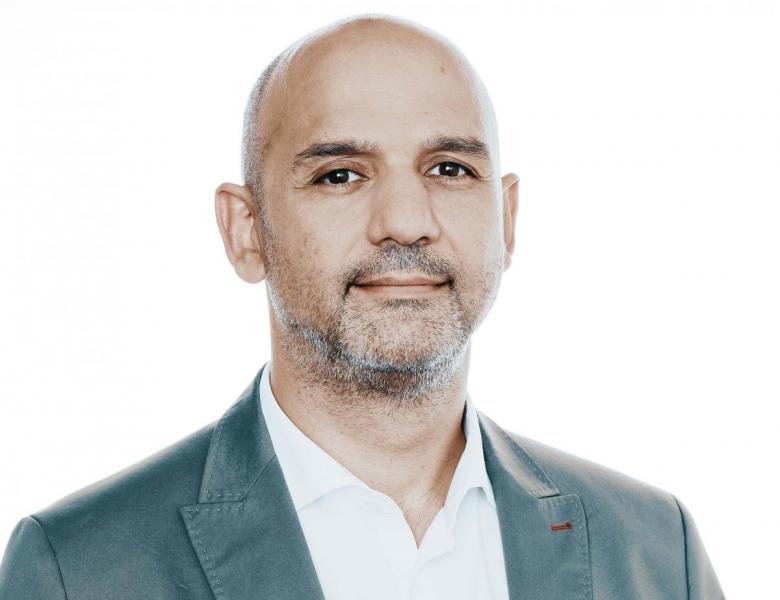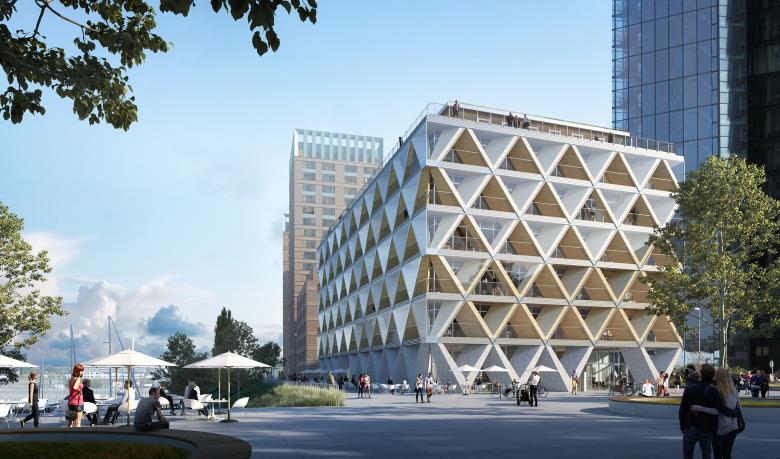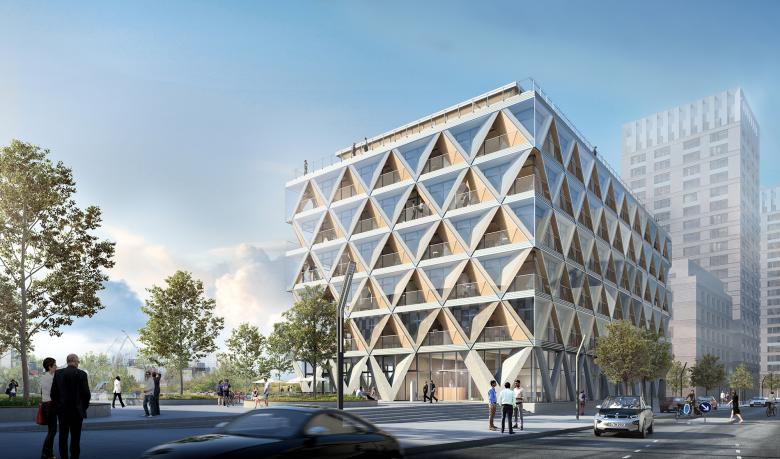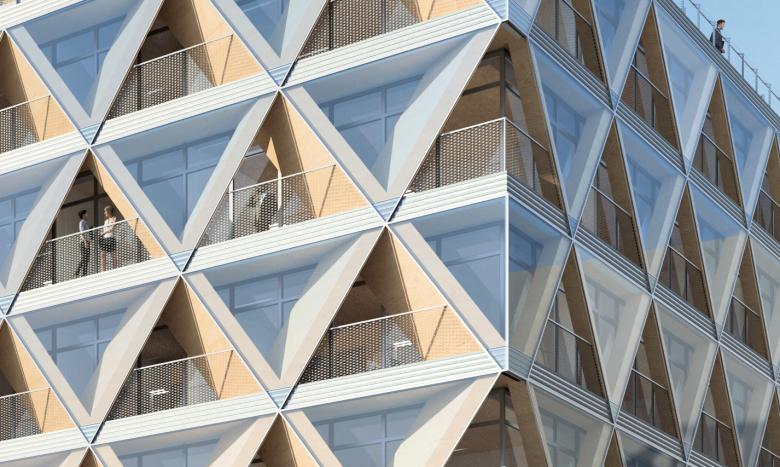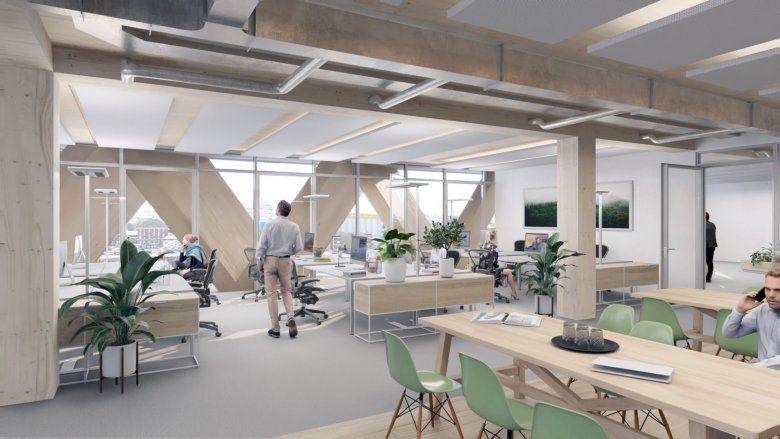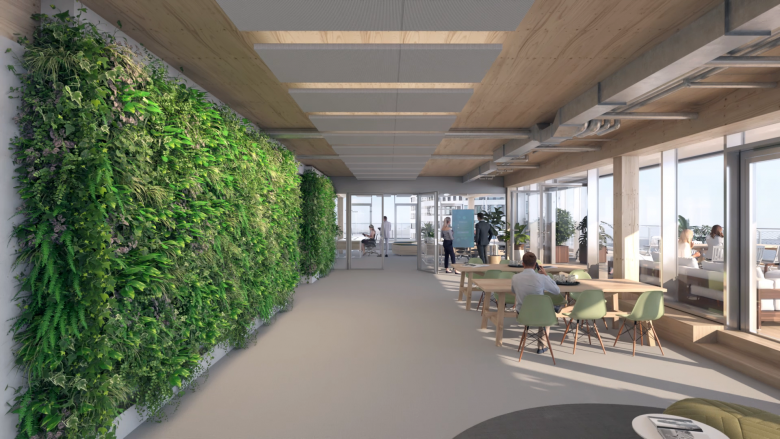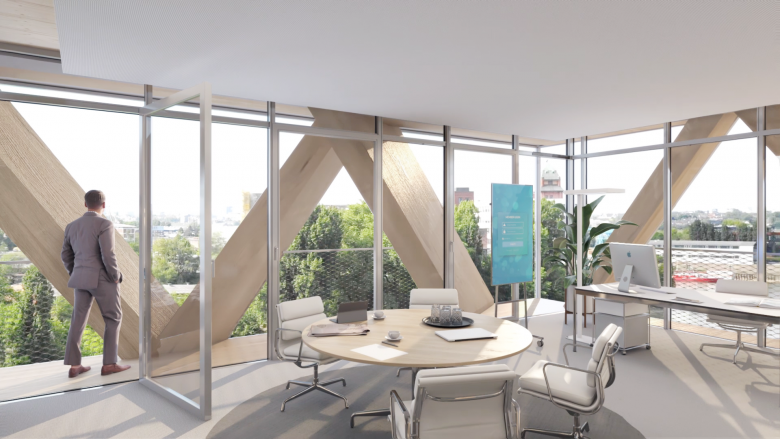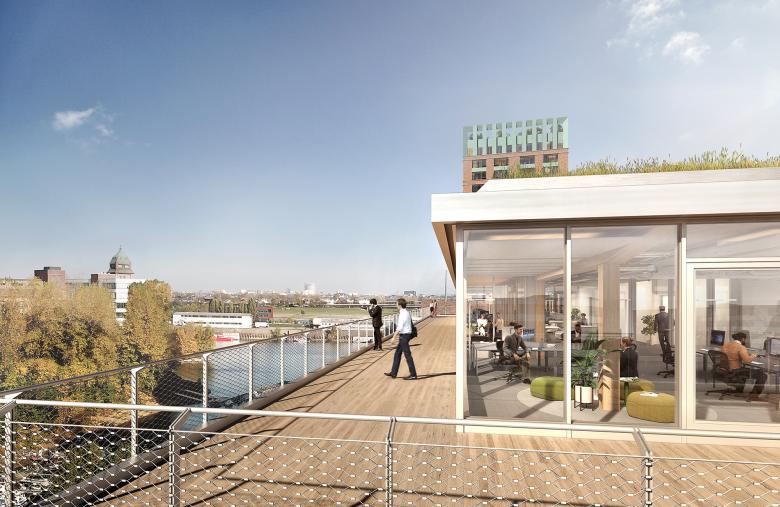Antonino Vultaggio: “I don’t see the home office as the primary workplace of the future; it rather complements the existing diversity of work forms.”
Photo: Chris Rausch © HPP Architekten
Before the pandemic, the team at HPP designed The Cradle office building for the INTERBODEN Group. Antonino Vultaggio is convinced that the flexibly usable timber hybrid building, which is designed to be recyclable and support a circular economy, continues to point the way to the future.
Mr. Vultaggio, most Germans are still reeling from the terrible images of the flood disaster. The floods made it painfully clear that climate change is a threatening reality. Is a change in values accelerating in society in the wake of such events? Do you notice an increased interest in sustainable architecture?Antonino Vultaggio: In Düsseldorf, our office building The Cradle is nearing completion. It is a lighthouse project where we combine our holistic sustainability concept with striking architecture. When we worked on our designs in 2017 and 2018, we had to make certain concessions. We were not able to implement everything that would have been ecologically desirable and technically possible. For example, we had plans to cool the building with groundwater and then channel it into the nearby Rhine. However, because the water in the area is contaminated with nitrates, the use of complicated purification technology would have been necessary. At the time, people thought the effort was too great for a single project. However, such decisions are always a snapshot in time. If we would start this project today, with the same client and the same specialist planners, we would probably get one step further. In short, the willingness to develop and finance ecological solutions has increased considerably this year. Currently, more tenders than ever before specify requirements which attach great importance to sustainability in a wide variety of forms. However, it is still difficult to initiate such a holistic project as The Cradle due to the often particular sustainable approaches.
Despite all the positive changes, there is still a lack of willingness to do more than is necessary in terms of sustainability on one’s own accord. However, I think the new EU taxonomy, which is supposed to help meet the goals of the Paris Climate Agreement — that is, CO2 neutrality by 2050 — will stir things up. It will have a direct impact on the construction industry. After all, if clients have to prove their compliance with the taxonomy, requirements will increase. The trend towards sustainable buildings will increase.
This lack of transparency is a problem for us as architects: we constantly have to investigate the actual sustainability of building materials and products, whether they contain toxic substances, how high their CO2 emissions and water consumption really are. We have to dig through an endless number of marketing brochures, and yet we hardly make any progress. That is tedious. We finally need transparency! And that is why we, together with the DGNB (German Sustainable Building Council), have launched an initiative, which other offices have joined, to formulate the material requirements for the industry from the architects’ point of view.
HPP Architekten, The Cradle, Düsseldorf (Visualization: bloomimages © INTERBODEN Gruppe / HPP Architekten)
Visualization: bloomimages © INTERBODEN Gruppe / HPP Architekten
Visualization: bloomimages © INTERBODEN Gruppe / HPP Architekten
The construction industry is currently producing huge amounts of waste. The Cradle is your answer to this as well: the building is a materials store.We thought about the recyclability of components and materials right from the start of the design process. This offers great potential not just ecologically, but also economically: The Cradle will be the first building in Germany to be registered on the Madaster platform — a global online register for materials and building products. In this way, material properties and raw material values are digitally linked. Thanks to Madaster’s connection to the commodity exchange, buildings can be mapped as valuable raw material deposits. This is an important step towards a functioning circular economy, and in the future, it will offer clients or owners the opportunity to take the material value of the building into account financially.
Of course! Just because we are increasingly working from home since the beginning of the pandemic does not mean that the office as a workplace has had its day.
After some initial skepticism at the beginning of the pandemic in spring 2020, I did notice a certain enthusiasm among some companies that working from home works so very well. But by the summer of the first year with the pandemic, a certain fatigue had set in and many were looking forward to returning to their office again. After all, for all its advantages, working predominantly from home demands a lot from people. For example, it is much more difficult to have a good exchange with colleagues. You have to be much more active than in the office, you have to ask questions and organize calls to stay informed. The social component is also affected. Digital meetings and phone calls, WhatsApp messages and e-mails simply cannot replace personal interaction. I don’t see the home office as the primary workplace of the future; it rather complements the existing diversity of work forms.
Visualization © INTERBODEN Gruppe
Visualization © INTERBODEN Gruppe
Visualization © INTERBODEN Gruppe
Visualization © INTERBODEN Gruppe
How will we use the office in the future? And what does that mean for the design of buildings like The Cradle?The emotional significance of the office will grow. The office of the future will be a place of exchange and inspiration. Creative processes in particular will continue to happen in places where people interact with each other. For us as architects, this means that we should focus on designing spaces where people enjoy coming together. At the same time, of course, focused work must still be possible. This means that different options have to be created from which employees can choose depending on their respective task. However, this is not really a new insight. The trend was already pointing in this direction before the pandemic. The coronavirus crisis proved to be an incubator, but it did not trigger the development.
And since you ask specifically about The Cradle, that’s basically what we did there. The interior design is modular to ensure great flexibility in use. It was also important to us to create a special atmosphere. That’s why we paid special attention to the issues of comfort and air quality. Wood is visible everywhere in the building. Thanks to the special façade construction, which simultaneously provides solar protection, the view of the harbor can always be enjoyed – unlike in the surrounding office buildings, where the shading devices are lowered and dark interiors are created during the summer months. Sophisticated technology, but also low-tech solutions such as green walls, ensure high indoor air quality. We have also avoided toxic chemicals such as carpet adhesives and PVC.
Focus on New Work, Sustainability and Home Office
Under the motto "Home of Consumer Goods", Ambiente, Christmasworld and Creativeworld will be held simultaneously for the first time at one of the world's most modern trade-fair centres from 3 to 7 February 2023. The new design of the Working product area under the umbrella of Ambiente, the world's leading trade fair for the sector, will create future-oriented impulses. At Ambiente Working, everything revolves around office supplies and office equipment – not only for the classic office, but also for mobile working, home offices, co-working spaces and the Future of Work.
www.consumergoods-frankfurt.com | www.ambiente.messefrankfurt.com/working
Future of Work Academy digital in the run-up to Ambiente in Frankfurt
The Future of Work Academy is aimed at architects, facility managers and planners as well as retailers of office supplies and furnishings. Following its successful premiere in 2017, this year a total of four lectures will shed light on the current changes in the world of work, digital solutions for collaboration and sustainable concepts for a modern workplace. The Future of Work Academy will deliver lectures online in the run-up to Ambiente on 2 May 2022 from 2 p.m. to 5 p.m., each will provide space for different perspectives on the subject of work.
Registration for the online lectures on 2 May 2022 with Peter Ippolito (Ippolito Fleitz Group), Jessica Borchardt (BAID Architekten), Margit Sichrovsky (LXSY Le Roux Sichrovsky Architekten), Petra Pfeiffer and Andreas Moser (Moser Assoziierte Architekten)
Paperworld 2022 – Future of Work Academy – Registration
World-Architects is a content partner of Messe Frankfurt.
